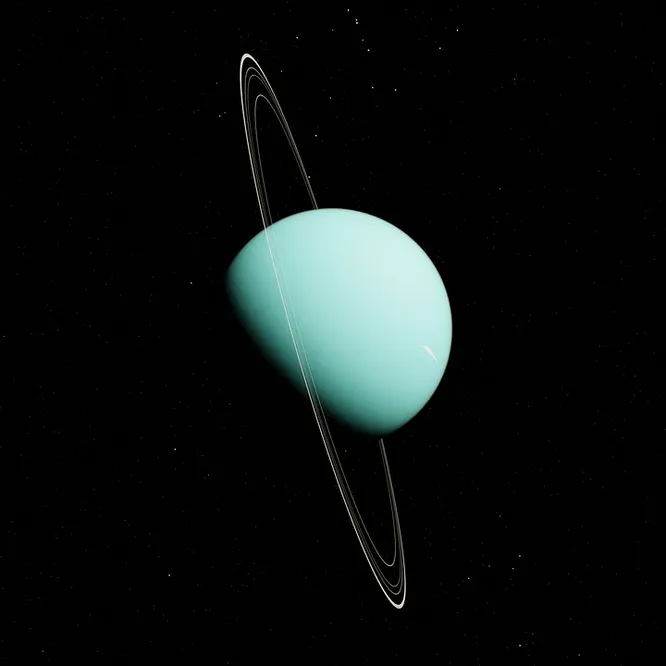Some new facts about the planets of our native Solar system cannot but surprise. It is to this kind of discoveries that some information about Uranus belongs. Astronomers have come to the conclusion that Uranus is the strangest planet and this is confirmed by many facts proven by researchers.

Who would have thought that even thirty years ago, most scientists considered the Solar System to be a rather boring place (well, maybe with the exception of Jupiter and Saturn). It seemed that our Earth revolves around the Sun in the company of little-noticed pieces of stone, where there is practically nothing interesting. The more surprising is the latest information, for example, about the oddities of Uranus. Below are the most interesting facts about this mysterious planet.
Inexplicably, but a fact!
Uranus is an absolutely amazing planet. Its peculiarity lies in the fact that the plane of the equator of Uranus is inclined to the plane of its orbit at an angle of 98 ° — that is, the planet rotates retrograde, as if lying on its side. This leads to serious consequences. If the rest of the planets of the Solar System are more like spinning tops, then Uranus is more like a rolling ball. This affects the change of day and night on the planet, as well as its magnetic field.
A new study by the Georgia Institute of Technology shows that Uranus’ magnetic field rotates with the planet, meaning it literally changes poles every day. The Earth’s magnetosphere is organized around the North and South Poles. Moreover, if these poles suddenly change places, then our planet may face a real catastrophe. And on On Uranus, a similar catastrophe occurs every new day. Its magnetosphere is chaotic, tilted at an angle of 60 degrees to the axis of rotation of the planet, and therefore sometimes it is “open” and sometimes “closed”.
The Strangest Planet: The Mysteries of Uranus
Uranus is the most mysterious and strange planet in the solar system. This is explained by the temperature regime of the planet, which is – 224 degrees Celsius – this is the coldest planetary atmosphere in the solar system! This interesting fact about Uranus makes the planet different from others. It emits a minimal amount of heat, unlike other giants of the solar system with hot cores. Wind currents on the planet are also striking. Astronomers have found that the wind speed on the planet can reach up to 900 kilometers per hour.
The authors of the study, Carol Patey and Qin Kao, using digital models based on data from Voyager 2, were able to simulate the activity of the magnetic field of Uranus and reveal some of its mysteries, including how it lets in the solar wind every day, then blocks it. An article about the study was published in the Journal of Geophysical Research: Space Physics. This discovery was made thanks to data from Voyager 2, which in 1986 only flew past the planet.

Uranus is named after the Greek God of the sky and was recorded by the famous astronomer William Herschel in 1781. Since ancient times, scientists have assigned Uranus the status of the strangest planet.
Storms on Uranus
One of the features of the planet Uranus is its unusual weather. According to NASA, when sunlight reaches some areas for the first time in many years, it heats up the atmosphere, thereby causing giant spring storms.
However, when the first photographs of Uranus appeared in 1986 during the hot weather in its south, the Voyager 2 space probe recorded a sphere with about 10 visible clouds. Surprisingly, it is thanks to this fact Uranus is considered not only the strangest, but also the “most boring planet”. However, many years later, the Hubble telescope replaced Voyager 2 and the seasons on Uranus also changed before astronomers caught extreme weather conditions on the planet.
For the first time raging summer storms were recorded in 2014. It is worth noting that such storms occurred seven years after Uranus approached the Sun. This strangest feature of Uranus has remained a mystery to researchers. In addition to storms on Uranus has diamond rains that descend thousands of miles below the surface of icy giant planets such as Uranus and Neptune. Astronomers note that carbon and hydrogen are compressed due to the extreme temperature and pressure in the atmosphere of these planets. Thus, diamonds are formed, which sink down, settling around the cores of Neptune and Uranium.
These interesting facts at the moment forced NASA to consider options for the development of this mysterious and strange planet. With a successful combination of circumstances , the mission on Uranus will be launched by 2034. It will help explain a lot of unexplained facts. Uranus is undoubtedly the most unusual planet in the Solar System. There is still a lot of research ahead that will help to understand many facts about this ice giant.
